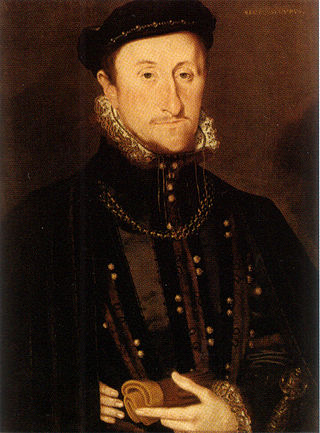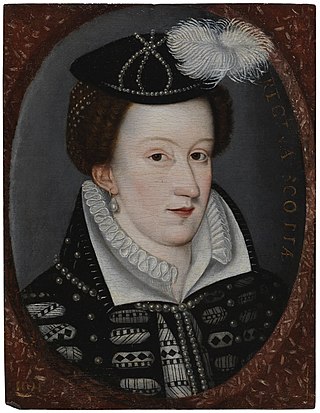Related Research Articles

John Erskine, 1st Earl of Mar was a Scottish aristocrat and politician. He was the custodian of the infant James VI of Scotland and Regent of Scotland.

The Chaseabout Raid was a rebellion by James Stewart, 1st Earl of Moray, against his half sister, Mary, Queen of Scots, on 26 August 1565, over her marriage to Henry Stuart, Lord Darnley. The rebels also claimed to be acting over other causes including bad governance, and religion in the name of the Scottish Reformation. As the government and rebel forces moved back and forth across Scotland without fighting, the conflict became known as the "chase about raid." Queen Mary's forces were superior and the rebel lords fled to England where Queen Elizabeth censured the leader.
William Ruthven, 1st Earl of Gowrie, 4th Lord of Ruthven was a Scottish peer known for devising the Raid of Ruthven.
Mary Livingston was a Scottish noblewoman and childhood companion of Mary, Queen of Scots, one of the famous "Four Marys".

Sir William Kirkcaldy of Grange was a Scottish politician and soldier who fought for the Scottish Reformation. He ended his career holding Edinburgh castle on behalf of Mary, Queen of Scots and was hanged at the conclusion of a long siege.

Dunbar Castle was one of the strongest fortresses in Scotland, situated in a prominent position overlooking the harbour of the town of Dunbar, in East Lothian. Several fortifications were built successively on the site, near the English-Scottish border. The last was slighted in 1567; it is a ruin today.
Lady Jean Stewart, was an illegitimate daughter of King James V of Scotland by his mistress, Elizabeth Bethune.

Ubaldini Migliorino, known also as "Captain Mellerin," was an Italian military engineer working in Scotland. He designed new fortifications at the entrances of Edinburgh Castle, Dunbar Castle, and possibly the walled town of Leith.

The Marian civil war in Scotland (1568–1573) was a period of conflict which followed the abdication of Mary, Queen of Scots, and her escape from Lochleven Castle in May 1568. Those who ruled in the name of her infant son James VI fought against the supporters of the Queen, who was exiled in England. Edinburgh Castle, which was garrisoned in her name, became the focus of the conflict and surrendered only after an English intervention in May 1573. The conflict in 1570 was called an "intestine war in the bowels of this commonwealth", and the period was called soon after an "intestine war driven by questions against authority."

The King's Wark in Leith was a building on the Shore of Leith, at the mouth of the Water of Leith into the Firth of Forth. The King's Wark was the Scottish royal arsenal where cannon used on royal ships were kept and maintained, and where supplies shipped to Leith for the royal household were stored. To the north east of the King's Wark the Shore was extended into the sea by a pier known as the "Bulwark". To the west was the Broad Wynd, and on the south, there was a walled yard. The site on the Shore includes a public house and restaurant called "The KIng's Wark" on the corner of the Shore and Bernard Street.
Margaret Beaton, Lady Reres was a Scottish courtier and companion of Mary of Guise and Mary, Queen of Scots. She was blamed by the enemies of Mary, Queen of Scots, for her involvement in alleged immorality at court.
Michael Gardiner was a Scottish artilleryman based at Stirling Castle. The surname also appears as Gardner and Gardenar.

John Stewart, Commendator of Coldingham (1531–1563) was a Scottish landowner.
Nicolas Errington was an English soldier, military engineer, and administrator.
Robert Anstruther was a Scottish soldier in the service of Mary of Guise and Mary, Queen of Scots.

James Mosman or Mossman was a Scottish goldsmith. He and his son John Mosman were supporters of the cause of Mary, Queen of Scots. James Mosman was executed in 1573 for counterfeiting coins in Edinburgh Castle. John Mosman carried letters for Mary, Queen of Scots, and was under surveillance by Francis Walsingham.
The baptism of James VI was celebrated at Stirling Castle in December 1566 with a masque, fireworks, and a staged assault on a mock fortress. The entertainment was devised by George Buchanan and Bastian Pagez.
Robert Colville of Cleish (1532–1584) was a Scottish courtier.
Arthur Erskine of Blackgrange was a Scottish courtier.

Jean de Compiègne or Jehan de Conpiegne was a French tailor who served Mary, Queen of Scots, in Scotland and England. He is frequently mentioned in her accounts and in her letters. His name appears in various spellings in Scottish records, including "Jean Decumpanze". He was also known as "Jehan Poulliet", and signed his name as "Jehan Poullyet".
References
- ↑ Accounts of the Treasurer, vol. 11 (Edinburgh, 1916), pp. 82-3.
- ↑ Accounts of the Treasurer, vol. 11 (Edinburgh, 1916), pp. 217-8.
- ↑ J. H. Pollen, Papal Negotiations with Mary Queen of Scots (SHS: Edinburgh, 1901), p. 450.
- ↑ James David Marwick, Extracts from the Records of the Burgh of Edinburgh: 1557–1571 (Edinburgh, 1875), p. 228.
- ↑ Register of the Privy Seal of Scotland, vol. 1 (Edinburgh, 1877), pp. 402-3.
- ↑ Register of the Privy Seal of Scotland, vol. 1 (Edinburgh, 1877), pp. 446-7, 474-5.
- ↑ Accounts of the Treasurer of Scotland vol. 2 (Edinburgh, 1970), pp. 58, 403–9.
- ↑ The Records of the Parliaments of Scotland to 1707, K.M. Brown et al eds (St Andrews, 2007-2013) Retrieved: 3 March 2013
- ↑ Exchequer Rolls of Scotland, vol. 19 (Edinburgh, 1898), pp. 282–3: Robertson, David, The Sculptured Stones of Leith (1851), p. 67
- ↑ Charles Thorpe McInnes, Accounts of the Treasurer: 1566-1574, vol. 12 (Edinburgh, 1970), pp. 84-5, 94.
- ↑ Charles Thorpe McInnes, Accounts of the Treasurer: 1566-1574, vol. 12 (Edinburgh, 1970), p. 121.
- ↑ Register of the Great Seal of Scotland, vol. 6 (Edinburgh, 1963), p. 141, no. 723.
- ↑ Calendar State Papers Scotland, vol. 3, p. 486.
- ↑ Fenelon, Bertrand De Salignac; Teulet, Jean Baptiste Alexandre Theodore; Cooper, Charles Purton (11 March 2024). "Correspondance Diplomatique De Bertrand De Salignac De La Mothe Fenelon. Publiee Pour La Premiere Fois Sur Les Manuscrits Conserves Aux Archives Du Royaume". Paris, 1838-40 – via Internet Archive.
- ↑ Calendar State Papers Scotland, vol. 3 (Edinburgh, 1903), pp. 478–80, 485–87, 529, 532–33, 535, 620–21, 623–4, 636.
- ↑ Calendar State Papers Scotland, vol. 4 (Edinburgh, 1905), p. 523, no. 586.
- ↑ Calendar State Papers Scotland, vol. 5 (Edinburgh, 1907), pp. 158–60, no. 167.
- ↑ Accounts of the Treasurer of Scotland, vol. 12 (Edinburgh, 1970), p. 379.
- ↑ Register of the Privy Council of Scotland, vol. 7 (Edinburgh, 1966), pp. 97, no. 659, 312 no. 1909.
- ↑ Register of the Great Seal of Scotland: 1580–1593 (Edinburgh, 1888), pp. 529–30, no. 1547.
- ↑ Calendar State Papers Scotland, vol. 6 (Edinburgh, 1910), pp. 312, 375, 441, 449.
- ↑ Aeneas James George Mackay, Chroniclis of Scotland, vol. 2 (Edinburgh, 1899), p. 257.